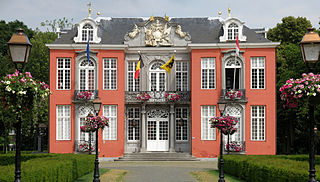
Gelderland, also known as Guelders in English, is a province of the Netherlands, occupying the centre-east of the country. With a total area of 5,136 km2 (1,983 sq mi) of which 173 km2 (67 sq mi) is water, it is the largest province of the Netherlands by land area, and second by total area. Gelderland shares borders with six other provinces and the German state of North Rhine-Westphalia.

Zutphen is a city and municipality located in the province of Gelderland, Netherlands. It lies some 30 km northeast of Arnhem, on the eastern bank of the river IJssel at the point where it is joined by the Berkel. First mentioned in the 11th century, the place-name appears to mean "south fen". In 2005, the municipality of Zutphen was merged with the municipality of Warnsveld, retaining its name. In 2021, the municipality had a population of 48,111.

Vorden is a former municipality and a town in the eastern Netherlands, about 10 kilometres south-east of Zutphen. On 1 January 2005 the municipality merged with Hummelo en Keppel, Steenderen, Hengelo en Zelhem, to form the new municipality Bronckhorst.

Bronkhorst is a village in the municipality of Bronckhorst, Gelderland, the Netherlands. Technically, it is a city and with only 157 inhabitants (2010), it is one of the smallest cities in the Netherlands.

Zoelen is a village in the Dutch province of Gelderland. It is a part of the municipality of Buren, and lies about 3 km north of Tiel. Castle Zoelen is located near the village.

Doorwerth Castle is a medieval castle situated on the river Rhine near the city of Arnhem, Netherlands.

Etten is a village in the Dutch province of Gelderland. It is located in the municipality of Oude IJsselstreek, 7 km southeast of Doetinchem.
On the territory of the municipality of Westerlo there are several castles.

D'Ursel Castle used to be the private summer residence of the Duke of Ursel in Hingene in the municipality of Bornem, province of Antwerp, Belgium. Today it is property of the State, and opened to the public.

Poeke Castle is a castle near Poeke, a small town in the municipality of Aalter in the Belgian province of East Flanders. The castle, standing in 56 hectares of park, is surrounded by water and is accessible through bridges at the front and rear of the building. Poeke Castle is situated at an elevation of 15 meters.

Ter Worm or Terworm Castle is a castle located in the municipality of Heerlen, Limburg Province, Netherlands. The castle is part of the Terworm estate.

Ammersoyen Castle is located in Ammerzoden in the Bommelerwaard region in the province of Gelderland, the Netherlands. When the original construction of the castle occurred is unclear; some sources claim it was as early as the 12th century. However, the consensus among historians is that the Van Herlaer family completed the castle in the 1350s. At the time of its construction, the castle was built along a branch of the river Maas. Just a few years after the construction of the castle was completed, the river was rerouted leaving the castle to be surrounded by a moat.

Cannenburg Castle or Cannenburch Castle is a watercastle in the Netherlands. It is situated in Vaassen, a town in the province of Gelderland.

Sorghvliedt Castle is a building in Belgium with a history dating back to the 16th century. It was originally a farm building called Wickeleynde owned by the merchant Jean Plaquet and his wife Maria Leydeckers. In 1660, it came into the hands of the du Bois family. From 1745 to 1750 it was completely rebuilt by Arnold du Bois. The Rococo structure was designed by the architect Jan Pieter van Baurscheit the Younger (1699–1768). The castle and the surrounding park were purchased by the town of Hoboken in 1937. It became the town hall in 1940. From 1983, following the extension of Antwerp, the castle became the district hall of Hoboken.

Hackfort Castle is a castle in Vorden, in the Dutch province of Gelderland. The castle is owned by the Vereniging Natuurmonumenten, the Society for Preservation of Nature Monuments.

Hernen Castle is a Dutch castle from the 14th century.

Ter Horst Castle is a castle northeast of the village of Loenen, in the Dutch province of Gelderland, on the road to Klarenbeek. In 1557, the then mayor of Arnhem Wynant Hacfort had the castle built.

Waardenburg Castle, sometimes also called Weerdenburg, is a medieval castle located in Waardenburg in the municipality of West Betuwe, in the Dutch province of Gelderland.

Merckenburg Castle, also known as Castle Heukelum, is a brick castle in the town of Heukelum in the municipality of West Betuwe in The Netherlands. It dates back to the 13th century. The castle has been destroyed and rebuilt twice. The first time was in the fourteenth century, the second time in the disaster year 1672, when the French blew up the building during the Franco-Dutch War. The castle was restored around 1700, attached to the keep that had not been destroyed by the explosions.


















